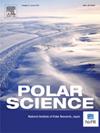Application of menthol anesthetics for body size measurements of the sea angel Clione elegantissima (Mollusca: Gymnosomata)
IF 1.5
4区 地球科学
Q3 ECOLOGY
引用次数: 0
Abstract
Understanding body size variation has been a central goal in ecology for almost half a century. However, it is difficult to measure the size of soft-bodied invertebrates accurately, such as members of the genus Clione, which expand and contract their bodies. To allow for accurate body length measurements, anesthetic menthol was used to temporarily relax the bodies of Clione elegantissima collected from the southern Okhotsk Sea. A standard solution was prepared using 1.4 g l-menthol dissolved in 250 mL ethanol. Three test solutions were then prepared using 0.1, 0.25, or 0.5 mL of the standard solution and dissolved in 20 mL of filtered seawater. Using a menthol-based anesthetic, the animals extended their body parts (including foot lobes, wings, and head tentacles), remained motionless, and showed no reaction to pricking with forceps. All tested animals returned to their actual sizes within 1–15 min after placing them back in filtered seawater, indicating that the menthol-based solutions were effective and harmless. The best concentration for measuring the body size C. elegantissima was 0.1 mL of the standard solution. It allowed not only bodies but head tentacles to stretch, providing to the full-length of Clione samples for body size measurements. We suggest that this anesthetic can be used as a new standard for body measurements and morphological observations in Clione species.
薄荷醇类麻醉剂在测量海象(软体动物:裸鱼)体型中的应用
近半个世纪以来,了解体型的变化一直是生态学的中心目标。然而,很难准确地测量软体无脊椎动物的大小,比如Clione属的成员,它们的身体可以扩张和收缩。为了精确测量体长,研究人员使用麻醉薄荷醇暂时放松了从鄂霍次克海南部采集的秀丽Clione elegantissima的身体。将1.4 g薄荷醇溶于250 mL乙醇制备标准溶液。然后用0.1、0.25或0.5 mL的标准溶液配制三种测试溶液,溶解在20ml过滤过的海水中。在使用薄荷类麻醉剂后,这些动物伸展了它们的身体部位(包括脚叶、翅膀和头触手),保持不动,对镊子刺痛没有反应。所有被试动物放回过滤过的海水中后,在1-15分钟内恢复到实际大小,表明薄荷醇溶液有效无害。标准溶液的浓度为0.1 mL,可用于测定草体大小。它不仅可以伸展身体,还可以伸展头部的触手,为测量体型提供了完整的Clione样本。我们认为这种麻醉剂可以作为克隆属动物身体测量和形态学观察的新标准。
本文章由计算机程序翻译,如有差异,请以英文原文为准。
求助全文
约1分钟内获得全文
求助全文
来源期刊

Polar Science
ECOLOGY-GEOSCIENCES, MULTIDISCIPLINARY
CiteScore
3.90
自引率
5.60%
发文量
46
期刊介绍:
Polar Science is an international, peer-reviewed quarterly journal. It is dedicated to publishing original research articles for sciences relating to the polar regions of the Earth and other planets. Polar Science aims to cover 15 disciplines which are listed below; they cover most aspects of physical sciences, geosciences and life sciences, together with engineering and social sciences. Articles should attract the interest of broad polar science communities, and not be limited to the interests of those who work under specific research subjects. Polar Science also has an Open Archive whereby published articles are made freely available from ScienceDirect after an embargo period of 24 months from the date of publication.
- Space and upper atmosphere physics
- Atmospheric science/climatology
- Glaciology
- Oceanography/sea ice studies
- Geology/petrology
- Solid earth geophysics/seismology
- Marine Earth science
- Geomorphology/Cenozoic-Quaternary geology
- Meteoritics
- Terrestrial biology
- Marine biology
- Animal ecology
- Environment
- Polar Engineering
- Humanities and social sciences.
 求助内容:
求助内容: 应助结果提醒方式:
应助结果提醒方式:


